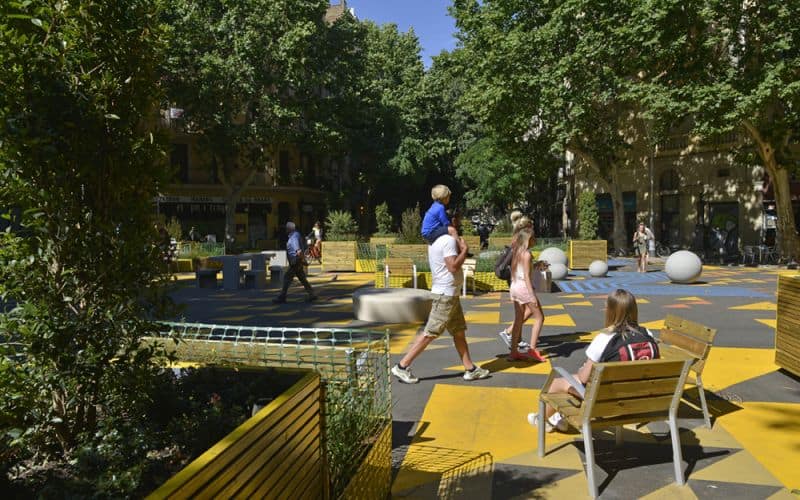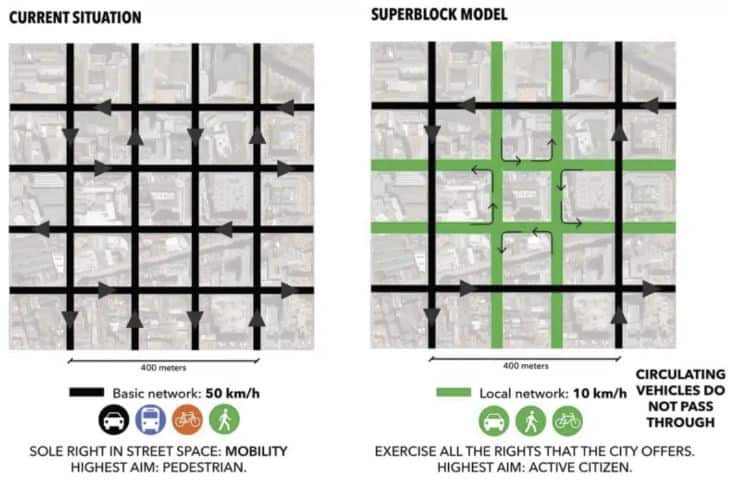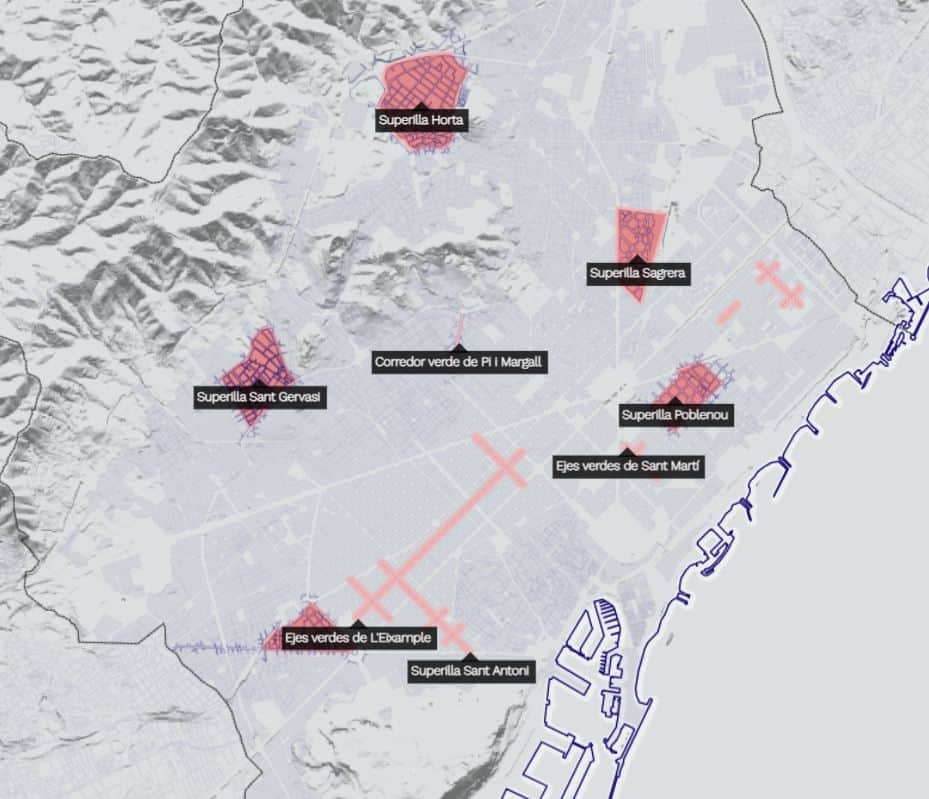
[Panorama Sustainable Cities] #6 Barcelona is being transformed thanks to superblocks
4 minutes of reading
in partnership with


Certain neighbourhoods and streets are gradually being returned to residents in Barcelona thanks to the superblock model, resulting in a clear decrease in pollution levels, an increase in the number of green spaces and a renewed sense of well-being in the heart of the bustling Catalan metropolis.

To combat the many pollutants and nuisances associated with car traffic, the city of Barcelona has embarked on a radical transformation aimed at reducing traffic and giving its residents a welcome breath of fresh air.
It is estimated that particulate pollution and nitrogen dioxide pollution is responsible for the deaths of between 1,000 and 3,500 people a year in the Catalan capital, while the noise levels in certain districts far exceed the maximum threshold recommended by the WHO. This is hardly surprising when you look at the figures. There are no fewer than 7,000 vehicles per km2 and more than 60% of public space is dedicated to cars. Barcelona is suffocating. This is why the municipality has been engaged in a vast mobility plan for almost fifteen years, with the main aim of reducing road traffic by 21%.
 The principle is to make these mini-neighbourhoods safe by drastically restricting road traffic, pedestrianising streets and intersections, adding plants to the urban space and installing infrastructure (benches, tables, play areas). The idea, in a nutshell, is to return public space to residents in a completely safe manner.
In reality, traffic is permitted within a superblock, but at a maximum speed of 10 km/h, and vehicles have to turn left. This makes through traffic impossible. Above-ground parking is also banned (only underground car parks and parking within buildings remain authorised). Road traffic within the superblocks is therefore automatically restricted to local residents. In contrast, green mobility is promoted and encouraged, café terraces are extended and children’s play areas are built. This dual approach against road traffic has enabled residents to reclaim the space that is rightfully theirs within neighbourhoods… and to be able to breathe again for good.
An emphasis has also been placed on adding vegetation to these new areas. This is a key point, as the city of Barcelona was lagging behind in this regard. As a result of an urbanisation model more closely resembling Tokyo than London, the city regularly becomes stifling at the first signs of heat because of the many urban heat islands created by the excessive covering over of vegetated areas. The introduction of green spaces has repeatedly proved to be effective in lowering temperatures locally.
The principle is to make these mini-neighbourhoods safe by drastically restricting road traffic, pedestrianising streets and intersections, adding plants to the urban space and installing infrastructure (benches, tables, play areas). The idea, in a nutshell, is to return public space to residents in a completely safe manner.
In reality, traffic is permitted within a superblock, but at a maximum speed of 10 km/h, and vehicles have to turn left. This makes through traffic impossible. Above-ground parking is also banned (only underground car parks and parking within buildings remain authorised). Road traffic within the superblocks is therefore automatically restricted to local residents. In contrast, green mobility is promoted and encouraged, café terraces are extended and children’s play areas are built. This dual approach against road traffic has enabled residents to reclaim the space that is rightfully theirs within neighbourhoods… and to be able to breathe again for good.
An emphasis has also been placed on adding vegetation to these new areas. This is a key point, as the city of Barcelona was lagging behind in this regard. As a result of an urbanisation model more closely resembling Tokyo than London, the city regularly becomes stifling at the first signs of heat because of the many urban heat islands created by the excessive covering over of vegetated areas. The introduction of green spaces has repeatedly proved to be effective in lowering temperatures locally.
 It is worth noting that the rapid transformation of these districts was made possible by the new techniques of tactical or transitional urbanism. The idea is to be able to adjust or modify a space temporarily (and above all quickly) for new uses through the use of flower boxes and lightweight infrastructure, such as wooden benches or tables, decorative elements and restriction barriers, etc. These techniques have the added advantage of not costing the municipality a lot of money and are very easy to adapt while giving the street a facelift.
It is worth noting that the rapid transformation of these districts was made possible by the new techniques of tactical or transitional urbanism. The idea is to be able to adjust or modify a space temporarily (and above all quickly) for new uses through the use of flower boxes and lightweight infrastructure, such as wooden benches or tables, decorative elements and restriction barriers, etc. These techniques have the added advantage of not costing the municipality a lot of money and are very easy to adapt while giving the street a facelift.
The installation of superblocks
Numerous measures have been put in place to try and achieve this, the most noted of which has been the introduction of a new type of model at a neighbourhood level: the superblocks (or superilles in Catalan). The city’s distinctive layout in the form of square blocks made it possible to come up with this new model as the areas where it would be applied could be easily demarcated. The principle is to make these mini-neighbourhoods safe by drastically restricting road traffic, pedestrianising streets and intersections, adding plants to the urban space and installing infrastructure (benches, tables, play areas). The idea, in a nutshell, is to return public space to residents in a completely safe manner.
In reality, traffic is permitted within a superblock, but at a maximum speed of 10 km/h, and vehicles have to turn left. This makes through traffic impossible. Above-ground parking is also banned (only underground car parks and parking within buildings remain authorised). Road traffic within the superblocks is therefore automatically restricted to local residents. In contrast, green mobility is promoted and encouraged, café terraces are extended and children’s play areas are built. This dual approach against road traffic has enabled residents to reclaim the space that is rightfully theirs within neighbourhoods… and to be able to breathe again for good.
An emphasis has also been placed on adding vegetation to these new areas. This is a key point, as the city of Barcelona was lagging behind in this regard. As a result of an urbanisation model more closely resembling Tokyo than London, the city regularly becomes stifling at the first signs of heat because of the many urban heat islands created by the excessive covering over of vegetated areas. The introduction of green spaces has repeatedly proved to be effective in lowering temperatures locally.
The principle is to make these mini-neighbourhoods safe by drastically restricting road traffic, pedestrianising streets and intersections, adding plants to the urban space and installing infrastructure (benches, tables, play areas). The idea, in a nutshell, is to return public space to residents in a completely safe manner.
In reality, traffic is permitted within a superblock, but at a maximum speed of 10 km/h, and vehicles have to turn left. This makes through traffic impossible. Above-ground parking is also banned (only underground car parks and parking within buildings remain authorised). Road traffic within the superblocks is therefore automatically restricted to local residents. In contrast, green mobility is promoted and encouraged, café terraces are extended and children’s play areas are built. This dual approach against road traffic has enabled residents to reclaim the space that is rightfully theirs within neighbourhoods… and to be able to breathe again for good.
An emphasis has also been placed on adding vegetation to these new areas. This is a key point, as the city of Barcelona was lagging behind in this regard. As a result of an urbanisation model more closely resembling Tokyo than London, the city regularly becomes stifling at the first signs of heat because of the many urban heat islands created by the excessive covering over of vegetated areas. The introduction of green spaces has repeatedly proved to be effective in lowering temperatures locally.
Tangible results
Obviously, the implementation of such a model is part of a firm, long-term policy commitment. Alongside other measures, such as the construction of numerous cycle paths and a revised and improved public transport plan, these new districts have delivered rapid results in terms of the two major pollution problems. The Sant Antoni district has seen a 30% reduction in nitrogen dioxide emissions and an 82% reduction in road traffic on the main roads within the superblock, while 33 hectares of space have been returned to residents in the Eixample district and more than 6 hectares of green space have been added. Similarly, in the Poblenou superblock, the surface area of green space has doubled and car traffic has fallen by 58%, resulting in a noise level that is now 5 decibels lower during the day compared to the average before the superblock was created. It is worth noting that the rapid transformation of these districts was made possible by the new techniques of tactical or transitional urbanism. The idea is to be able to adjust or modify a space temporarily (and above all quickly) for new uses through the use of flower boxes and lightweight infrastructure, such as wooden benches or tables, decorative elements and restriction barriers, etc. These techniques have the added advantage of not costing the municipality a lot of money and are very easy to adapt while giving the street a facelift.
It is worth noting that the rapid transformation of these districts was made possible by the new techniques of tactical or transitional urbanism. The idea is to be able to adjust or modify a space temporarily (and above all quickly) for new uses through the use of flower boxes and lightweight infrastructure, such as wooden benches or tables, decorative elements and restriction barriers, etc. These techniques have the added advantage of not costing the municipality a lot of money and are very easy to adapt while giving the street a facelift.
Rebuilding social links
The implementation of this concept is the work of the former director of the Urban Ecology Agency of Barcelona, Salvador Rueda. Pedestrianising neighbourhoods is a model that has been tried out all over the world. Salvador Rueda has been designing and ‘developing’ it for the city of Barcelona since 1993, when the first superblock was built in the El Born district. There are now 6 superblocks in Barcelona, some of which have been developed on the scale of entire districts rather than just a few intersections. This is the case with Superilla Sant Gervasi and Horta. However, the model of these blocks goes further in its approach. The concept allows residents to reclaim the urban space that has been left to vehicles for many years. These new districts have made it possible to incorporate the notions of well-being and improved coexistence once again within a metropolis that badly needed it. Streets that are pedestrianised in this way become true civic spaces – places where people can meet, relax and socialise once more. Only when road traffic in the city is drastically reduced can it be rediscovered and transformed into a fantastic area for recreation. The Catalan capital has won several urban planning awards, and many of the world’s major cities are giving serious thought to implementing this new kind of urban model.More reading
Read also




What lies ahead? 7 megatrends and their influence on construction, real estate and urban development
Article
20 minutes of reading

